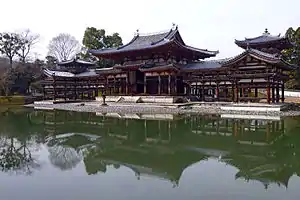Battle of Uji (1180)
The first battle of Uji is famous and important for having opened the Genpei War.
| First Battle of Uji | |||||||
|---|---|---|---|---|---|---|---|
| Part of the Genpei War | |||||||
 The Phoenix Hall of the Byōdō-in, in front of which the battle took place | |||||||
| |||||||
| Belligerents | |||||||
|
|
| ||||||
| Commanders and leaders | |||||||
|
Minamoto no Yorimasa † Prince Mochihito † |
Taira no Tomomori Taira no Shigehira | ||||||
In early 1180, Prince Mochihito, the Minamoto Clan's favored claimant to the Imperial Throne, was chased by Taira forces to the Mii-dera, a temple just outside Kyoto. Due to the interference of a Mii-dera monk with Taira sympathies, the Minamoto army arrived too late to help defend the temple.
Minamoto no Yorimasa and Prince Mochihito, along with a force of about fifteen hundred men including the warrior monks of Mii-dera and the Watanabe clan, fled south towards Nara.[2] They crossed the Uji River, just outside the Byōdō-in, and tore up the planks of the bridge behind them to prevent the Taira following them.[3]
Three warrior monks in particular are named in the Heike Monogatari: Gochi-in no Tajima, Tsutsui Jōmyō Meishū, and Ichirai Hōshi. These three, along with the other monks of Mii-dera, fought with bow and arrow, a variety of swords and daggers, and naginata.[4]
As for the Taira troops, they were led by Ashikaga Tadatsuna, one of the few warriors of direct Minamoto descent who stayed loyal to his oath to the Taira family even when it was crumbling around him, until he and his father were murdered by one of their retainers, Kiryū Rokurō. A young 18 year old hero, Tadatsuna is remembered as having the strength of one hundred men, a voice that echoed over 10 li (5 km), and teeth of 1 sun (3.03 cm) long. Describing it as such, Azuma Kagami further stated that "there will be no warrior in future ages like this Tadatsuna."
Led by their young general, the Taira force soon began to ford the river and caught up with the Minamoto. Tadatsuna was the first warrior on the frontline, and gallantly proclaimed his name and lineage before charging the enemies, as it was the traditional custom. Yorimasa tried to help the Imperial Prince get away, but was struck with an arrow in the right elbow. While his sons, Nakatsuna and Kanetsuna were dying to fend off the enemies eager for the old man's head, Yorimasa committed seppuku.[4]
"Yorimasa committed hara-kiri in a way that was to set the standard for generations to come."[5]
As for Prince Mochihito, he was captured and killed shortly afterwards by the Taira warriors.[3]
References
- Turnbull, Stephen (2016-07-28). The Gempei War 1180–85: The Great Samurai Civil War. Bloomsbury Publishing. p. 19. ISBN 9781472813862. Retrieved 2018-06-21.
- ""The Heike Monogatari"".
- Sansom, George (1958). A History of Japan to 1334. Stanford University Press. p. 278. ISBN 0804705232.
- Turnbull, Stephen (1977). The Samurai, A Military History. MacMillan Publishing Co., Inc. pp. 42–47. ISBN 0026205408.
- Turnbull, Stephen (1998). The Samurai Sourcebook. Cassell & Co. p. 200. ISBN 1854095234.
Bibliography
- Turnbull, Stephen (2003). Japanese Warrior Monks AD 949-1603. Oxford: Osprey Publishing.